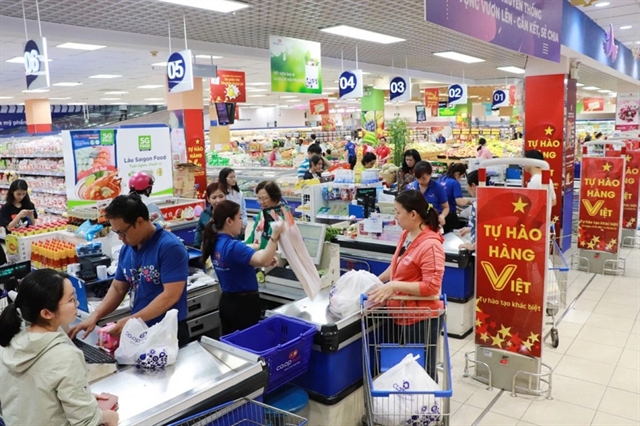 Economy
Economy

 |
| Trần Thanh Hải, deputy director of the Import and Export Department, Ministry of Industry and Trade. |
HÀ NỘI - Việt Nam's exports have faced difficulties in recent months due to a reduction in the purchasing power of many major export markets. This has led to an 11.6 per cent decrease in export orders from local enterprises during the first five months of 2023.
Trần Thanh Hải, deputy director of the Import and Export Department, Ministry of Industry and Trade, spoke to Vietnam News Agency about solutions to help businesses overcome difficulties and promote trade activities with other countries.
How do you assess Việt Nam's import and export situation in the first five months of 2023?
Việt Nam's trade revenue achieved double-digit growth in 2021 and 2022. But growth has slowed down this year due to inflation, economic recession and lower purchasing power in many traditional export markets.
In the first five months of 2023, the value of exports was estimated at US$136.17 billion, down 11.6 per cent over the same period in 2022, while the value of imports was estimated at $126.37 billion, down 17.9 per cent.
In terms of commodity groups, the export values fell by 21 per cent for seafood, 13-14 per cent for raw materials and processed products, and 3.7 per cent for agricultural products. Việt Nam saw a reduction in exports in almost all of its major markets.
What has the Government done to support for the businesses in diversifying export markets in this difficult time?
Free trade agreements (FTAs) between Việt Nam and its partners have brought opportunities to diversify export markets for local businesses.
Now, Việt Nam has 15 FTAs under operation. The FTA with Israel has ended negotiations and it is expected to sign this year.
Some new FTAs of Việt Nam are expected to be effective in the near future such as the one with the UAE. This country is a vibrant market in the Middle East and it can become a gateway for Việt Nam to export more goods to the Middle East and Africa.
The Southern Common Market (Mercosur) consisting of six countries in South America is a potential market for Việt Nam to tap into, especially considering Việt Nam has already signed FTAs with a number of countries in this bloc, such as Chile and Peru.
However, Việt Nam does not have yet FTAs with other members of Mercosur, including the larger markets like Brazil and Mexico. Việt Nam is stepping up negotiations to sign FTAs with those members.
This is the first priority of Việt Nam in diversifying export markets for local businesses.
There are still many regions with large export markets such as Africa and South Asia with countries like Iran, Iraq, Afghanistan and Pakistan that we are yet to tap into. Việt Nam continues to research those markets and plans negotiations with them to sign FTAs.
Imports and exports are foretasted to face more obstacles and double-digit trade growth is unlikely this year. What is the Ministry of Industry and Trade doing to create favourable conditions for enterprises to increasing exports?
One of Việt Nam's biggest advantages is that production is maintained very well. But Việt Nam is facing difficulty in the markets so it is focusing on solving this problem.
First of all, the efficient exploitation of FTAs will open up great opportunities for local businesses. The current FTAs cover most of the major markets and there is still high potential in increasing exports here.
One more thing is trade promotion. The removal of tariff and non-tariff barriers is an important solution, but it is only one of the obstacles that Việt Nam faces when entering the global market.
There are still many difficulties regarding exports if Việt Nam's businesses do not know about demands and requirements of foreign import markets, even if the barriers are removed.
Besides helping local businesses find new customers and new business opportunities, trade promotion activities also play a big role in boosting the chances of local businesses being able to enter foreign markets and grasp the requirements of those markets.
In the current difficult context, customers are more likely to choose suppliers that are reliable and able to meet requirements on environmental protection and reducing emissions.
Besides that, customers are now more likely to choose products from businesses that have factories meeting green standards.
For example, global demand is decreasing, yet Bangladesh is still seeing growth in export orders because Bangladeshi textile and garment enterprises make an effort to get green certificates.
The Ministry of Industry and Trade is very interested in diversifying sources of market information for businesses, especially from Việt Nam trade offices abroad.
It has websites providing market research for local businesses to help them find more opportunities abroad.
Besides State support, how can enterprises maintain growth of commodity exports?
Many businesses have opted to focus on the domestic market after hearing about challenges in exporting to foreign markets. This is an initiative of enterprises to maintain production and business.
In fact, many export-focused enterprises are also struggling to reach the domestic market. Meanwhile, some businesses say that they are familiar with the domestic market and cannot reach foreign markets.
Each market has its own characteristics and challenges and a business may be interested in tapping into both markets. For example, a business may export more products than the volume sold at the domestic market and vice versa depending on each period.
For the domestic or export market, finding reliable partners and meeting the needs of consumers are key factors.
Businesses need professional staff to grow sales and develop brand strategies, especially for export activities.
There are still some industries processing a large volume of export products while still struggling to capture the real demand of the market.
Besides investment in machinery and technology, investment in human resources is an important factor in being able to grasp the actual requirements of foreign markets to increase sales there.
Businesses also need to optimise operations to reduce logistics costs. This will be a factor in gaining production efficiency, reducing costs and overcoming difficulties. VNS




